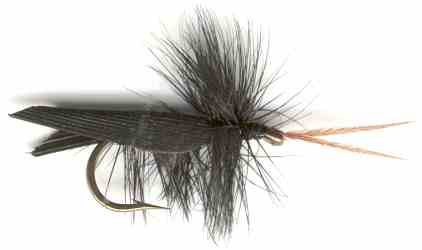Black Horned Tent-winged Caddis (Sedge) Fly
The Black Horned Tent-winged Caddis is an ideal pattern to imitate dark winged caddis like the Dark Blue Sedges (genus Psilotreta) that have dusty gray/green bodies but near black wings their favorite habitat is upland streams and small freestone rivers.

CADDIS FLY PATTERNS. Hook size 10 12 14 - $US each
Several weeks before their summer hatch (normally in June) the larvae group together in tightly stacked clumps under stream bed rock to pupate. This is the reason that during the hatch some stretches of water will have a dense population and others stretches will be sparse. The best time to fish this caddis dry fly is when the female returns to the water to lay her eggs on the water surface while continuing to move across it. The large hackle near the eye of the hook and the long tail allows the hook point to penetrate the surface imitating the caddis dragging its egg sac into the water as it moves along the water. This style of caddis fly pattern is commonly called a "Tent Wing" caddis pattern very similar to the King's River Caddis and the Hemingway. It has a 'down wing' made of feather, over a palmered body with a hackle collar. The term 'down wing' is used to illustrate that the pattern is different from normal Mayfly dry fly patterns that have 'up wings'
Most caddis fly fishing is in the twilight with lots of airborne insects and others on the water skittering across the surface as they try to take off after hatching before a hungry trout grabs them for their dinner from down below. There is another type of Caddis fly fishing on smooth water with helpless dying caddis and trout with refined taste sipping the surface, taking time picking out what they want to eat, being choosy. The first type of caddis fly fishing can be great fun but if you do not have the correct fly the second scenario can lead to failure. Big bushy elk hair wing caddis flies will not normally work. They will not fool the selective feeding trout. You need to have a selection of flat water caddis patterns that give a more realistic silhouette

Slow or still water caddis are commonly smaller than those on rough faster water. Smaller insects tend to hatch for longer periods and more profusely. On slow water I use low quick casts rather than high slow ones so the trout cannot see my line. I always try to make my false casts off to the side. These to methods will help to avoid spooking the fish. if you fish with novices, are a beginner or you have poor eyesight, fish two flies with a smaller more realistic tent winged horned caddis fly trailing behind a larger more visible fly like a buoyant Goddard's Caddis Fly (G&H Sedge)
The common or slang term ‘sedge’ originates from the fact that adult Caddis flies can often be found clinging to sedge grass near the waters. Sedge/Caddis flies have four wings. The forward pair are normally a little longer than those at the rear. At rest their wings lie close along the body in an inverted V shape. Caddis flies do not have tails but many have long antenna. The Latin name for this group of flies is ‘Trichoptera’ (Greek for 'hairwing'). They pass through four stages in their development; egg, larva, pupa and adult. The eggs are laid by the adult female in large jelly mass, which often floats on the water surface and drift until they stick to some river side vegetation. Some species lay their eggs directly on vegetation
CUSTOMER'S COMMENT
Tent Winged Caddis in size 16, 14 and 12 are in my top ten list of flies. Most of my fishing is on rivers and streams in Maine, USA. Occasionally I'll canoe a few ponds. Most noted are the rivers of Kennebec, Penobscot, Moose, Crooked, Rapid, Messalonskee, Kenebago, Grand Lake Stream, Magaloway, Dead River, Kenduskeag and Sebasticook. As always tight lines, Jeff Haresear
GOOGLE+ READER'S COMMENT
In Southern Chile is a very
effective for bows. Rodolfo Fernandez, Chile


Fly Fishing books

